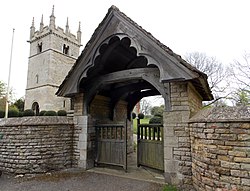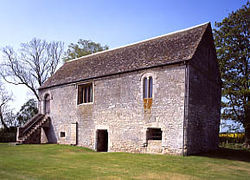Boothby Pagnell
| Boothby Pagnell | |
| Lincolnshire | |
|---|---|

| |
| Location | |
| Grid reference: | SK971308 |
| Location: | 52°52’0"N, 0°33’29"W |
| Data | |
| Post town: | Grantham |
| Postcode: | NG33 |
| Local Government | |
| Council: | South Kesteven |
| Parliamentary constituency: |
Grantham and Stamford |
Boothby Pagnell is a village and parish in the Kesteven part of Lincolnshire, within the wapentake of Winnibriggs and Threo. The population is now included in the civil parish of Bitchfield and Bassingthorpe.
Contents
History
Boothby Pagnell has a Grade-I-listed[1] surviving fragment of a mediæval manor house, in the Norman style, dating from around 1200.[2][3]
The village was a small community, its population in 1086 being just 19. It has archeological remains at 'Cooks Close', a field west of the church, which is chiefly of medieval housing that seems to have fallen into disuse and dereliction by the 14th century, possibly as a result of the desertion of the workforce in the aftermath of the Black Death.
John de Bothby, Lord Chancellor of Ireland, was born here about 1320 and took his name from the village.
Isaac Newton
Although his uncle William Ayscough, the brother of Hannah Ayscough, was vicar of nearby Burton Coggles, during his time of discovery in 1666–67, Newton spent some time in the summer at the rectory of Boothby Pagnell, which had a considerable orchard. The vicar was the Trinity College Fellow Humphrey Babington, the brother of Katherine Babington. She was a friend of Hannah Ayscough and the wife of William Clark, the owner of the house at which Newton lodged in Grantham while at school.
In his memoirs, Newton noted that he worked on Fluxions (which became differential calculus) at Babington's rectory, and also calculated the area under a hyperbola (involving integral calculus).
Geography
The village is just north of Bitchfield and south of Old Somerby on the B1176 and approximately five miles south-east of Grantham. According to the 2001 census it had a population of 150. Boothby Pagnell forms the most western point of 'The Ropsley Triangle', which denotes the general area between Ropsley, Boothby Pagnell and Ingoldsby.
Ecclesiastical parish
The local authority, and the Ordnance Survey, spell the village "Boothby Pagnell".[4] The Diocese of Lincoln spells it as "Boothby Pagnall".[5]
The ecclesiastical parish is part of The North Beltisloe Group of parishes in the Deanery of Beltisloe.[5]
Boothby Pagnell Grade-I-listed Anglican parish church is dedicated to St Andrew[6] Restored in 1896, it has a Norman tower, font and nave arcades.[7] It also has a canonical sundial on the south wall.
References
- ↑ National Heritage List 1360056: Boothby Manor House
- ↑ Service, Alastair (1982). Anglo-Saxon and Norman : A guide and Gazetteer. The Buildings of Britain. ISBN 0-09-150130-X.
- ↑ Historic England. "Boothby Hall (325707)". PastScape. http://www.pastscape.org.uk/hob.aspx?hob_id=325707. Retrieved 20 March 2010
- ↑ "Boothby Pagnell Parish Council". http://parishes.lincolnshire.gov.uk/BoothbyPagnell/. Lincolnshire.gov.uk
- ↑ 5.0 5.1 "Boothby Pagnall P C C". 16 July 2011. https://web.archive.org/web/20110716073201/http://www.lincoln.anglican.org/search_parishes.php?14023050.
- ↑ National Heritage List 1062868: Church of St Andrew
- ↑ Cox, J. Charles (1916) Lincolnshire p. 68; Methuen & Co. Ltd.
Outside links
| ("Wikimedia Commons" has material about Boothby Pagnell) |
- "Boothby Pagnell", Genuki.org.uk. Retrieved 30 June 2011
- Newton: "The Expert View", Open University
- "Boothby Pagnell", Boothby Pagnell Village website
